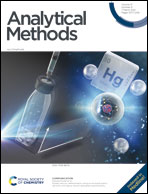High-performance electrochemical sensing platform based on sodium alginate-derived 3D hierarchically porous carbon for simultaneous determination of dihydroxybenzene isomers†
Abstract
Three-dimensional hierarchically porous carbon (denoted as SA-900) with a microporous, mesoporous and macroporous structure was facilely fabricated via direct carbonization of sodium alginate. SA-900 was fully characterized by N2 adsorption–desorption, scanning electron microscopy (SEM), transmission electron microscopy (TEM), X-ray diffraction and Raman spectroscopy to confirm its structure. SA-900 was coated onto a glassy carbon electrode surface to construct an ultrasensitive electrochemical sensing platform (SA-900/GCE). Electrochemical behaviors of hydroquinone (HQ), catechol (CC) and resorcinol (RC) on the SA-900/GCE surface were investigated, and it was found that SA-900 possesses excellent electrocatalytic activity towards them. Experimental conditions including carbonization temperature, pH value, SA-900 concentration, accumulation potential and accumulation time were optimized for quantitative assay. Under optimized conditions, linear ranges for simultaneous determination of HQ, CC and RC are 0.05–1.50 μM, 0.05–1.50 μM and 0.50–15.00 μM, respectively. Detection limits for HQ, CC and RC are calculated to be 0.0183 μM, 0.0303 μM and 0.3193 μM (S/N = 3). The SA-900/GCE based electrochemical sensing platform is applied for determining HQ, CC and RC in lake water samples with satisfactory results.



 Please wait while we load your content...
Please wait while we load your content...